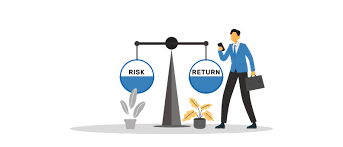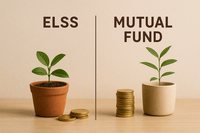Understanding Risk and Return in Mutual Funds

Putting money into mutual funds can be a good method to build up your savings over time. But there are two essential notions that you need to know about every investment: risk and return. Kubera Wealth is here to help you learn the basics of mutual funds and become a more informed investor. This book tells you what risk and return are, why they are important, and how you may use this information to make smart decisions.
What Do Mutual Funds Do?
A mutual fund is a way for a lot of people to put their money together and invest it. Then, the money that was pooled together is used to buy other types of assets, such as stocks, bonds, or other securities. When you buy shares of a mutual fund, you own a part of the fund's investment portfolio.
Professionals who run mutual funds decide what to acquire and sell. This means that even if you're new to investing, you'll still enjoy the benefit of skilled management.
Things Everyone Should Know About Mutual Funds
-
Pooling Money: Getting money from a lot of investors and putting it all together to invest.
-
Diversification: It means putting money into a lot of different things to lower risk.
-
Professional Management: People who know what they're doing take care of your money.
-
You can purchase or sell your shares at any moment during market hours, which is called liquidity.
-
Returns: You can make money by selling assets for more than you paid for them, getting dividends, or getting interest.
Learning these basic facts about mutual funds is a great way to start your investing career.
What Do Return and Risk Mean?
Two fundamental factors of investing are risk and return. They always go together.
Risk is the chance that you won't get back what you put in or that you will lose money.
Return is the money you make from your investment, which is usually displayed as a percentage of the amount you put in.
In general, taking on more risk can lead to bigger returns. But it also implies that you are more likely to lose money. You can make better, more sure decisions if you know the risk and return of an investment.
Different Kinds Of Risks Come With Investing In Mutual Funds
There are dangers that all mutual funds encounter. These are the primary types:
-
Market Risk: Changes in the economy might cause the value of stocks and bonds to go up or down.
-
Credit Risk: The risk that a borrower won't pay back loans or bonds.
-
Interest Rate Risk: Bond prices might change when interest rates go up or down.
-
Liquidity Risk: Sometimes it's hard to sell assets rapidly without losing money.
-
Risk of Inflation: If inflation goes up, your returns might not grow fast enough to keep up with the cost of living.
You can choose funds that are right for you by knowing these risks.
Why Are Risk and Return Important?
You need to find a balance between how much profit you want and how much risk you can handle when you invest. Every investor has various goals and levels of risk they are willing to take.
You might like lower-risk funds better if you seek stability and a steady income.
You might choose higher-risk equities funds if you desire more growth and are okay with ups and downs.
Risk and return also help you stay calm when the market goes down. If you know there is some danger, you can stay calm and keep your investments for bigger long-term rewards.
How to Handle Risk When Investing in Mutual Funds
The key is to diversify. If you spread your money out over different funds and types of assets, you lower your risk. For instance:
-
Stocks have a larger risk and a higher chance of making money over time.
-
Debt funds are more stable, but they don't make as much money.
-
Balanced funds combine both to fit the average person's risk tolerance.
Know How Much Risk You Can Handle
Know how much danger you can take on without getting stressed. Your age, income, and financial goals all determine how much risk you are willing to take. Young investors can frequently afford to take more risks than retirees.
Look At How Well The Fund Is Doing And Who Manages It.
Check how the fund has done in different market scenarios. Find out what people say about the fund manager and how well they have done in the past.
Focus On The Long Term
Most of the time, mutual funds reward investors who are patient. Don't let short-term changes in the market affect you. The longer you keep your money in an investment, the more time it has to grow and make up for losses.
Raising Awareness Among Investors
To be an informed investor, you need to know about mutual funds and the stock market so you can make good decisions.
Get Information From Sources You Can Trust.
Spend some time reading, watching videos, and going to webinars. Kubera Wealth gives you expert advice and resources to help you learn.
Stay Away From Common Mistakes
Don't try to make rapid money or listen to what the market says.
Don't put money into something you might need shortly.
Don't give in to the impulse to move money around all the time.
Use Money Management Tools
You can use Kubera Wealth's calculators to figure out how much money you can make from mutual funds, create your Systematic Investment Plans (SIPs), and keep an eye on the health of your portfolio. These tools help you stay on track with your investments.
Knowing the many types of mutual funds and how much risk and return they offer
There are numerous types of mutual funds, and each has a different amount of risk and return expectations:
-
Equity Funds: Put most of their money into stocks. More danger, but also more chances to make money in the long run.
-
Debt Funds: Put money into bonds and other fixed-income investments. Less risk, steadier returns.
-
Hybrid Funds: These funds have both stocks and bonds, with a balance that makes them moderately risky.
-
Liquid Funds: Low risk, utilized to keep short-term money safe.
Your financial goals and how comfortable you are with risk can help you choose the right category.
What Systematic Investment Plans (SIPs) Do?
SIPs let you put a certain amount of money into mutual funds on a regular basis. By spreading out the investments over time, this technique makes market volatility less of a problem. It also helps you develop a disciplined saving habit, which is very important for long-term success.
How Kubera Wealth Helps You with Your Mutual Fund Journey
You have the necessary information and tools thanks to Kubera Wealth. You get comprehensive help picking mutual funds that fit your goals, from articles that are easy to read to expert financial guidance. Their platform has:
-
Use financial calculators to assess SIPs, returns, and goals.
-
Information about how mutual funds are doing and what trends are happening.
-
We send you regular updates and blogs to keep you up to date.
-
Individualized help to help you make investment choices.
Conclusion
Any mutual fund investor has to know about risk and return. You may make investments that fit your financial goals and risk tolerance by learning the basics of mutual funds and becoming more conscious of what investors do. Don't forget that investing isn't a way to get rich quickly. It's about making sensible choices, being patient, and growing steadily.
You have a partner in Kubera Wealth to help you along the way. Use the information and resources you have to make your financial future safer and brighter.





















